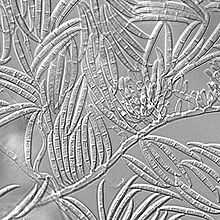| Gibberella zeae | |
|---|---|

| |
| Scientific classification | |
| Domain: | Eukaryota |
| Kingdom: | Fungi |
| Division: | Ascomycota |
| Class: | Sordariomycetes |
| Order: | Hypocreales |
| Family: | Nectriaceae |
| Genus: | Gibberella |
| Species: | G. zeae
|
| Binomial name | |
| Gibberella zeae (Schwein.) Petch, (1936)
| |
| Synonyms | |
|
Botryosphaeria saubinetii | |
Gibberella zeae, also known by the name of its anamorph Fusarium graminearum, is a fungal plant pathogen which causes fusarium head blight (FHB), a devastating disease on wheat and barley.[1] The pathogen is responsible for billions of dollars in economic losses worldwide each year.[2] Infection causes shifts in the amino acid composition of wheat,[3] resulting in shriveled kernels and contaminating the remaining grain with mycotoxins, mainly deoxynivalenol (DON), which inhibits protein biosynthesis; and zearalenone, an estrogenic mycotoxin. These toxins cause vomiting, liver damage, and reproductive defects in livestock, and are harmful to humans through contaminated food. Despite great efforts to find resistance genes against F. graminearum, no completely resistant variety is currently available. Research on the biology of F. graminearum is directed towards gaining insight into more details about the infection process and reveal weak spots in the life cycle of this pathogen to develop fungicides that can protect wheat from scab infection.
- ^ Bai G, Shaner G (2004):Management and resistance in wheat and barley to Fusarium head blight. Annual Review of Phytopathology 42: 135–161 [1]
- ^ De Wolf ED, Madden LV, Lipps PE (2003): Risk assessment models for wheat Fusarium head blight epidemics based on within-season weather data. Phytopathology 93: 428-435. [2]
- ^ Beyer M, Aumann J (2008): Effects of Fusarium infection on the amino acid composition of winter wheat grain. Food Chemistry 111: 750-754. [3]